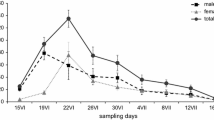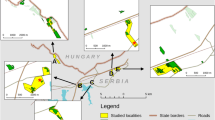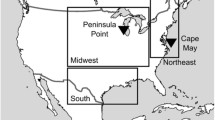Summary
The comparative analysis of life tables of the oriental moth,Monema flavescens, obtained in 6 patches for 8 generations in 4 years revealed the following:
-
1.
The ratio of maximum to minimum of cocoon density for each patch ranged from 5.34 to 22.50, each value being more than 3.20, the ratio for the whole study area.
-
2.
The density change from adult to cocoon in the next generation caused most of the spatial variation in density change per patch. The rate of adult-to-cocoon population change showed spatial density dependence in some generations but not in others. When the change rate lacked spatial density dependence, it was the key-factor for spatial variation in adult density for the following few generations till the change rate recovered spatial density dependence. This was because of flooding, which killed the spatial density dependence existing potentially in the adult-to-cocoon change rate and damaged the same patches during the few successive generations.
-
3.
The rate of population change from overwintered generation adults (summer ones) to first generation cocoons was not only the key-factor for the rate of throughout-the-year change but temporally density dependent in each patch. Therefore, the density for the whole study area is considered to fluctuate within a range. However, the strong equilibrium seen in the cocoon density for the whole study area was due to the floods that happened to occur when the density was near and at its maximum, and it is considered that such a strong equilibrium does not always occur.
-
4.
In the population change from summer adults to first generation cocoons, temporal density dependence was found in all the patches, but it was found only in one patch in the population change from autumn adults to second generation cocoons. This was because the spatial density dependence seen in the former corresponded to the absolute density of adults, while that in the latter corresponded to the relative density.
Similar content being viewed by others
References
Andrewartha, H. G. and L. C. Birch (1954)The Distribution and Abundance of Animals. University of Chicago Press, Chicago.
Andrewartha, H. G. and L. C. Birch (1984)The Ecological Web: More on the Distribution and Abundance of Animals. University of Chicago Press, Chicago.
den Boer, P. J. (1968) Spreading of risk and stabilization of animal numbers.Acta Biotheor. 18: 165–194.
den Boer, P. J. (1981) On the survival of populations in a heterogeneous and variable environment.Oecologia 50: 39–53.
den Boer, P. J. (1985) Fluctuations of density and survival of carabid populations.Oecologia 67: 322–330.
Ehrlich, P. R. (1965) The population biology of the butterfly,Euphydryas editha II. The structure of the Jasper Ridge Colony.Evolution 19: 327–336.
Ehrlich, P. R. and L. C. Birch (1967) The “balance of nature” and “population control”.Amer. Nat. 101: 97–107.
Hassell, M. P. (1985) Insect natural enemies as regulating factors.J. Anim. Ecol. 54: 323–334.
Hassell, M. P. (1987) Detecting regulation in patchily distributed animal populations.J. Anim. Ecol. 56: 705–713.
Hassell, M. P., T. R. E. Southwood and P. M. Reader (1987) The dynamics of the viburnum whitefly (Aleurotrachelus jelinekii): a case study of population regulation.J. Anim. Ecol. 56: 283–300.
Iwao, S. (1971a) Dynamics of numbers of a phytophagous lady-beetle,Epilachna vigintioctomaculata, living in patchily distributed habitats. 129–147. In P. J. den Boer and G. R. Gradwell (eds)Dynamics of populations. Pudoc, Wageningen.
Iwao, S. (1971b) Life table (4).Plant Protection 25: 497–501 (In Japanese)
Iwao, S. (1972) Outbreaks of terrestrial animals. Chap. 7 Epilogue. 79–82. InOutbreaks of Living Things by S. Iwao and T. Hanaoka. Kyoritsu, Tokyo. (In Japanese)
Iwao, S. (1981) Spatio-temporal dynamics of populations. 186–205. In S. Ishii (ed.)Recent Advances in Entomology. University of Tokyo Press, Tokyo. (In Japanese)
Iwao, S. and E. Kuno (1971) An approach to the analysis of aggregation pattern in biological populations. 461–513. In G. P. Patil, E. C. Pielou and W. E. Waters (eds)Statistical Ecology I. Pennsylvania State University Press, University Park.
Kuno, E. (1973) Statistical characteristics of the density-independent population fluctuation and the evaluation of density-dependence and regulation in animal populations.Res. Popul. Ecol. 15: 99–120.
Kuno, E. (1981) Dispersal and the persistence of populations in unstable habitats: a theoretical note.Oecologia 49: 123–126.
Kuno, E. and N. Hokyo (1970) Comparative analysis of the population dynamics of rice leafhoppers,Nephotettix cincticeps Uhler andNilaparvata lugens Stål with special reference to natural regulation of their numbers.Res. Popul. Ecol. 12: 154–184.
Milne, A. (1957) The natural control of insect populations.Can. Entomol. 89: 193–213.
Mountford, M. D. (1988) Population regulation, density dependence, and heterogeneity.J. Anim. Ecol. 57: 845–858.
Podoler, H. and D. Rogers (1975) A new method for the identification of key factors from life-table data.J. Anim. Ecol.,44: 85–114.
Sanders, C. J. and G. S. Lucuik (1975) Effects of photoperiod and size on flight activity and oviposition in the eastern spruce budworm (Lepidoptera: Tortricidae).Can. Entomol. 107: 1289–1299.
Shiga, M. (1977) Population dynamics ofMalacosoma neustria testacea (Lepidoptera: Lasiocampidae): stabilizing process in a field population.Res. Popul. Ecol. 18: 284–301.
Sokal, R. R. and F. J. Rohlf (1981)Biometry (2nd ed). Freeman, New York.
Southwood, T. R. E. (1966)Ecological Methods. Methuen, London.
Stewart-Oaten, A. and W. W. Murdoch (1990) Temporal consequences of spatial density dependence.J. Anim. Ecol. 59: 1027–1045.
Strong, D. R. (1984) Density-vague ecology and liberal population regulation in insects. 313–327. In P. W. Price, C. N. Slobodchikoff and W. S. Gaud (ed)A New Ecology, Wiley, New York.
Strong, D. R. (1986) Population theory and understanding pest outbreaks. 37–58. In M. Kogan (ed)Ecological theory and Integrated Pest Management Practice. Wiley, New York.
Stubbs, M. (1977) Density dependence in the life-cycles of animals and its importance inK- andr-strategies.J. Anim. Ecol. 46: 677–688.
Varley, G. C. and G. R. Gradwell (1960) Key factors in population studies.J. Anim. Ecol. 29: 399–401.
Yamada, Y. (1987a) Factors determining the rate of parasitism by a parasitoid with a low fecundity,Chrysis shanghaiensis (Hymenoptera: Chrysididae).J. Anim. Ecol. 56: 1029–1042.
Yamada, Y. (1987b) Characteristics of the oviposition of a parasitoid,Chrysis shanghaiensis (Hymenoptera: Chrysididae).Appl. Entomol. Zool. 22: 456–464.
Yamada, Y. (1988) Optimal use of patches by parasitoids with a limited fecundity.Res. Popul. Ecol. 30: 235–249.
Yamada, Y. (1990) Role of a parasitoid with a low fecundity,Praestochrysis shanghaiensis (Hymenoptera: Chrysididae), in the population dynamics of its host.Res. Popul. Ecol. 32: 365–379.
Author information
Authors and Affiliations
Rights and permissions
About this article
Cite this article
Yamada, Y. Spatio-temporal analysis of the population dynamics of the oriental moth,Monema flavescens (Lepidoptera: Limacodidae). Res Popul Ecol 34, 109–130 (1992). https://doi.org/10.1007/BF02513525
Issue Date:
DOI: https://doi.org/10.1007/BF02513525




